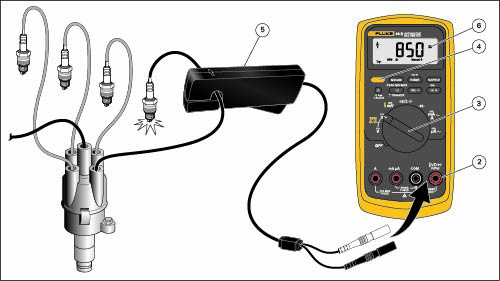Modern automotive diagnostics rely on precise rotations per minute (RPM) measurements to identify idle problems, misfires, or inconsistencies in engine performance. The Fluke 88V multimeter, built specifically for automotive applications, allows you to measure RPM accurately using an inductive pickup. This guide walks you through RPM testing step by step with a multimeter.

Why the Fluke 88V Is the Perfect Tool for Automotive Testing
The Fluke 88V is a high-performance digital multimeter tailored for automotive environments. It can measure RPM, duty cycle, voltage, resistance, and more. With its rugged build and included accessories like the inductive RPM pickup, it’s ideal for working on both modern and older vehicles.
Step-by-Step Guide to Testing Engine RPM with a Multimeter
It’s important to know which multimeter features will come in handy when measuring RPM. Here are the four most relevant to this task:
- Function selection: Use RPM2 for 4-cycle engines (spark every other revolution) or RPM1 for 2-cycle engines and 4-cycle waste-spark systems (spark every revolution).
- Correct jacks: Use the COM and RPM input ports.
- Relative mode (REL): Optional — use only if you need to compare two RPM readings. This is not required for basic checks.
- Smooth mode: Averages fluctuating readings. Enable it by powering the meter off, holding the Range button, and powering on again
Before you get started, make sure to wear safety glasses and gloves to protect against heat, sparks, or moving belts, and keep cables and clothing clear of rotating parts during testing. Always check lead placement, especially for RPM measurements using the dedicated RPM jack.
Quick reference note: Numbers appearing in parentheses after steps—e.g., (3)—correspond to callouts in the Reference Figure: Measuring RPM with Inductive Pickup above.
Step 1. Turn the Engine Off
Ensure the engine is completely off and cool enough to work around.
Step 2. Connect the Inductive Pickup
- Plug the black lead of the pickup into the COM (2)
- Plug the red lead into the RPM (2)
- Clamp the pickup around a spark-plug wire near the plug. (5)
- Ensure the jaws are fully closed.
- The side labeled “SPARK PLUG SIDE” should face the plug.
Step 3. Configure the Meter
- Turn the rotary switch to DC volts. If the reading is noisy, switch to AC volts (3)
- Press the yellow secondary-function button once for RPM2 or twice for RPM1. (4)
Step 4. Start the Engine
- Start the vehicle.
- Observe the RPM value on the multimeter’s display. (6)
Step 5. Adjust for Stability (Optional)
- If the reading fluctuates:
- Press the Range button once to raise the trigger level from 6 V to 60 V.
- Use Smooth mode (see above) to average out signal spikes if needed.
Step 6. Interpret the Reading
- Compare the displayed RPM to the vehicle’s service-manual specification.
- Common idle RPM ranges:
- 600 – 900 RPM (gasoline engines)
- 500 – 750 RPM (diesel engines)
Step 7. Shut Down and Disconnect Safely
- Turn the engine off before disconnecting the pickup.
- Unplug the pickup leads from the meter.
Tips and Best Practices
- Reverse the pickup: On waste-spark systems, reversing the pickup orientation may correct inaccurate readings.
- Utilize Smooth mode: This helps eliminate unstable digits in the RPM display.
- Avoid hot components: Always let the engine cool if working in tight areas near exhaust manifolds.
Using the 88V for Precise Diagnostics
Measuring engine RPM with a multimeter helps confirm idle stability, diagnose misfires, and verify post-repair performance. With the right setup and attention to safety, it becomes a quick and reliable diagnostic step in any technician’s workflow.
An automotive-oriented multimeter like the Fluke 88V makes it even easier to ensure measurement accuracy when working on vehicles.